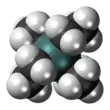Tetraethyltin
Tetraethyltin or tetraethyl tin is a chemical compound with the formula C
8H
20Sn and molecular structure (CH3CH2)4Sn, that is, a tin atom attached to four ethyl groups. It is an important example of an organotin compound, often abbreviated as TET.
| |||
| Names | |||
|---|---|---|---|
| IUPAC name
Tetraethyltin | |||
| Other names
Tetraethyl tin Tetraethylstannane | |||
| Identifiers | |||
3D model (JSmol) |
|||
| Abbreviations | TET | ||
| ChemSpider | |||
| ECHA InfoCard | 100.009.007 | ||
| EC Number |
| ||
| MeSH | Tetraethyltin | ||
PubChem CID |
|||
| UNII | |||
| UN number | 3384 | ||
CompTox Dashboard (EPA) |
|||
| |||
| |||
| Properties | |||
| C8H20Sn | |||
| Molar mass | 234.958 g·mol−1 | ||
| Appearance | Colourless liquid | ||
| Density | 1.187 g cm−3 | ||
| Melting point | −112 °C (−170 °F; 161 K) | ||
| Boiling point | 181 °C (358 °F; 454 K) | ||
| Hazards | |||
EU classification (DSD) (outdated) |
|||
| R-phrases (outdated) | R26/27/28 R50/53 | ||
| S-phrases (outdated) | S26, S27, S28, S45, S60, S61 | ||
| NFPA 704 (fire diamond) | |||
| Flash point | 53 °C (127 °F; 326 K) | ||
| Related compounds | |||
Related Tetraalkylstannanes |
Tetrabutyltin | ||
Related compounds |
Tetraethylgermanium | ||
Except where otherwise noted, data are given for materials in their standard state (at 25 °C [77 °F], 100 kPa). | |||
| Infobox references | |||
Tetraethyltin is a colourless flammable liquid, soluble in diethyl ether and insoluble in water, that freezes at -112 °C and boils at 181 °C.[1][2] It is used in the electronics industry.
Tetraethyltin can be obtained by reacting ethylmagnesium bromide with tin(IV) chloride:[1]
- SnCl4 + 4 (C2H5)MgBr → (CH3CH2)4Sn + 4 MgBrCl
The same reaction can be used to obtain tetra-n-propyltin and tetra-n-butyltin.[1]
Tetraethyltin is converted in the body to the more toxic triethyltin.[3]
See also
References
- G. J. M. Van Der Kerk and J. G. A. Luijten (1956), "Tetraethyltin". Organic Syntheses, volume 36, page 86; Coll. Vol. 4, p.881 (1963)
- SAFC corp, tetraethyltin catalog page. Accessed on 2011-01-18.
- Schmid, D. O.; Cwik, S. (1975). "R receptors on lymphocytes of sheep". Animal Blood Groups and Biochemical Genetics. 6 (1): 61–62. doi:10.1111/j.1365-2052.1975.tb01351.x. PMID 1200418.
This article is issued from Wikipedia. The text is licensed under Creative Commons - Attribution - Sharealike. Additional terms may apply for the media files.


